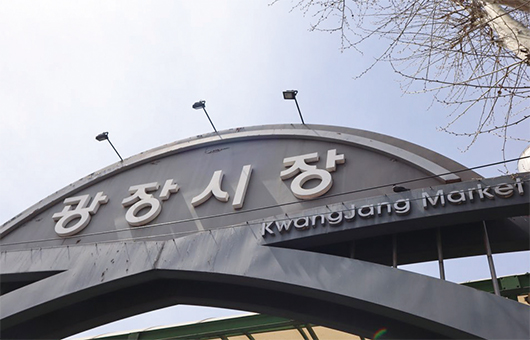
Seoul City represents the material prosperity of South Korea. When we think of Seoul, we usually imagine wonderful nightscape of the city. Meanwhile, Seoul also shows the exhausting life of Koreans. If so, can we not sense anything cozy in Seoul? The UOS Times can dismiss that question confidently after we visited Gwangjang Market. Through mass media, many people may already have heard about Gwangjang Market, but there are not many programs that have conveyed informative details. From now on, The UOS Times is going to describe the attractions of Gwangjang Market.
Gwangjang Market is situated in Changgyeonggung-ro, Jongno-gu, Seoul. It is easy to access in that Gwangjang Market is located nearby exit 8 of Jongno 5-ga Station of Line 1. If you visit this place from the University of Seoul (UOS), it takes no more than 30 minutes to get there. Before you visit Gwangjang Market, note that Gwangjang Market opens from 9 a.m. to 6 p.m. and it does not open every Sunday. Unlike other Korean traditional markets, you can use credit cards as a means of payment in this market.
Having been operated since 1905, Gwangjang Market is the biggest and oldest conventional market in Korea. In this aspect, Gwangjang Market also conserves Korean traditional culture well including clothes, foods, and so on.

Nowadays, it is not difficult to find people who wear Hanbok, which is a traditional garment of Korea. Especially, near ancient palaces like Gyeongbokgung Palace, many people wear Hanbok. However, that is not Korean traditional Hanbok but modernized Hanbok. In reality, without watching historical dramas, we cannot easily see traditional Hanboks. At Gwangjang Market, The UOS Times could easily enjoy diverse traditional Hanboks of the Joseon era. There are some aligned areas of stores that sell traditional Hanbok. Particularly, traditional Hanbok shops deal with wedding clothes of the Joseon dynasty. Maybe you have a memory of seeing traditional wedding clothes in the wedding pictures of your grandparents. If you come here, that is not an amazing thing but reality. Although Koreans prefer modernized Hanboks because it is more comfortable, Gwangjang Market strictly adheres to the beauty of traditional Hanboks.
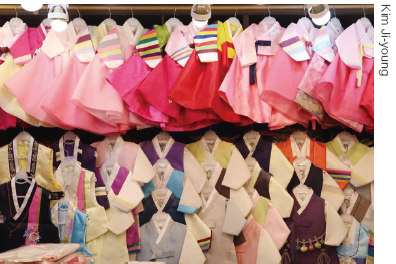
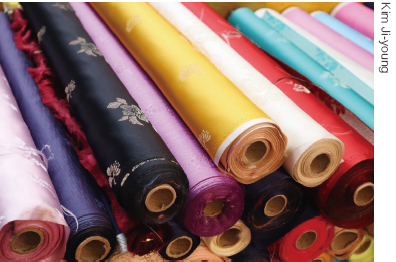
Also, many Koreans these days usually sleep on beds. Maybe you also sleep on a bed. On the contrary, most Koreans in the past usually slept on the floor. Imagine traveling to the countryside to visit your grandparents’ house. Most Korean readers may have reminiscences of sleeping on the floor with thick and white bedding. At this market, you can see bedding similar to that of your grandparents’ house. Traditional beddings of Gwangjang Market are manufactured by handicrafts men who have engaged in this field for a long time.
At Gwangjang Market, there are many wholesalers of beddings, so you can find not only traditional beddings but also modern beddings and purchase them at a comparatively cheap price than other general bedding stores of Seoul.

Every Sunday, Gwangjang Market is closed except for this area. There is a vintage clothes shopping district that operates every day, apart from national holidays. Walking through Jongno 5-ga Station exit 11, you can easily find the shopping district. If you visit this vintage clothes shopping district, at first, you can see many people touting their shops fiercely. Across the street, there are many stores that sell imported old clothes.

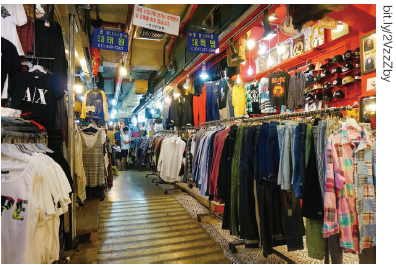
Through television programs, many people already know about this shopping district. Usually, people might think of vintage clothes as old-fashioned and shabby. However, there are so many brand-name clothes you have heard of and can be found in the boutique of department stores at this district. You can express your individuality through Gwangjang Market’s vintage clothes. There is a distinct characteristic on the stores of this district. These stores do not have any signs. Visitors can just see the phone numbers of storekeepers and their touting. Someone might think that sellers would solicit harshly or improperly. Fortunately, visitors do not have to worry about that. Nowadays, you do not have to undergo annoying situations because there are many crackdowns on excessive touts and rude actions of storekeepers to customers. Although the roads of this district are cramped and musty, the composure and distraction of Gwangjang vintage clothes shopping district is fairly indulging.

The food section is the most vibrant place in the Gwangjang Market and it starts from the East Gate. It has various kinds of food categories such as Pyebaek food for marriage expenses, seafood and dry fish, butcher shops, rice cakes, groceries, side dishes, and healthy foods. As it sells many kinds of foods, depending on the characteristics of the product, operating hours are different by stores. Accordingly, The UOS Times recommend that you search on the Internet before you visit any store of the food section. Gwangjang Market offers access to fresh, high-quality food ingredients, and you can also buy delicious and cheap side dishes made by Gwangjang Market merchants themselves.
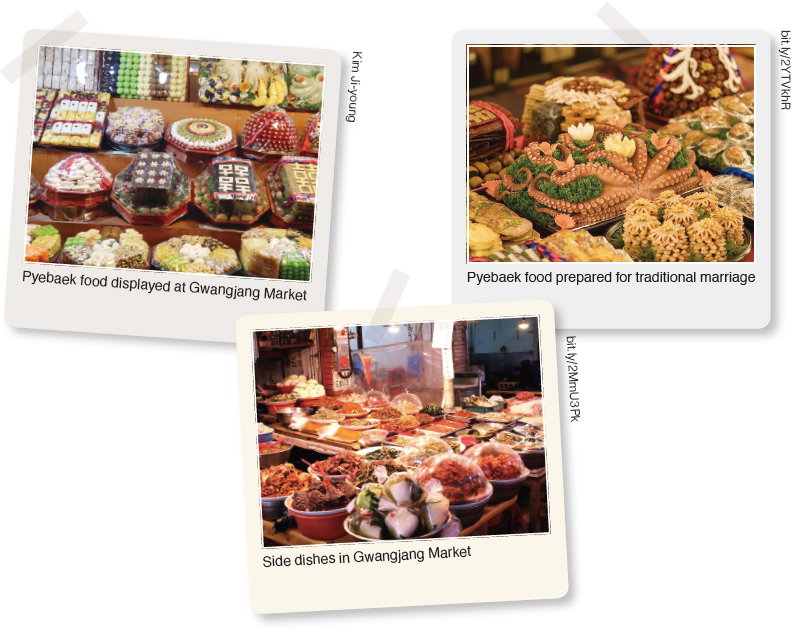
In Gwangjang Market, you can often see shops that offer Pyebaek food for Honsu, which is usually hard to come across. Honsu refers to items prepared by men and women in the process of marriage, preparing to be a family. Pyebaek is a part of a traditional wedding to pay respect to the bride or groom’s family by the newly-wedded couple right after their wedding. In other words, Pyebaek food is something that a bride prepares for the first time to greet her in-laws. For decades, Gwangjang Market has been offering a variety of fresh and high-quality Pyebaek food needed for Korean marriage culture.
The Gwangjang Market is very crowded before the holidays because of the preparation of the ceremonial table for their ancestors. Although the setting of the table varies depending on regions and families, the alternative food composition is similar. It consists of rice cakes, fruits, seafood, and dried fish. It is possible for you to set up a ceremonial table with foods served in this market. The UOS Times recommend you to visit the food section of Gwangjang Market where you can feel Korean culture and tradition, and buy delicious and fresh ingredients cheaply.

In Gwangjang Market, you can find people enjoying a variety of delicious street foods. This section from the second gate to the first gate is called the “Mukja Alley.” It opens from 9 a.m. to 11 p.m. all year round, but there are some places that are not operating on their own, so once again, we recommend you to search for their exact hour of business. The food alley of Gwangjang Market sells various kinds of food such as Korean, Japanese, and more. These foods can be packed for take-out, but it is more delicious to eat at the spot where you bought it as you can feel Gwangjang Markets’ atmosphere and the warm food at the same time.

The “signature menu” of Gwangjang Market is kimbap, a small kimbap with the nickname “drug kimbap,” which means “I want to continue to eat it as if I am addicted to it.” Bindatteok (Mung-bean pancake, in English) is also popular. Its’ size is quite big, so it is good to share with friends. Yukhoe (Korean style raw beef, in English), which received a Michelin Star from Michelin Guide, is famous for its freshness. Although there are so many places where they put up signs that they invented the food, so it is hard to know which store actually invented the food and where you should go to. Nevertheless, wherever you go, you can actually feel the warm hearts of merchants in Gwangjang Market through the special taste of foods and friendly services in any store.
If you are planning to visit a place to go with your friends or family, Gwangjang Market might be the best answer. After visiting Gwangjang Market, The UOS Times can say for sure that not only Mukja Alley but also the sections of Hanbok, traditional bedding, vintage clothes, and food are worth visiting. Have fun by feeling the tradition of Korea and eating delicious foods at Gwangjang Market.
Park Hyung-min
dmm789456@uos.ac.kr
Kim Ji-young
zzero9999@uos.ac.kr

